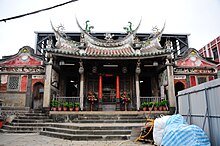Mazu Temple (Magong)
The Mazu Temple is a Chinese temple of the Chinese sea goddess Mazu, the deified form of the medieval Fujianese shamaness Lin Moniang, located at 1 Zhengyi Street (正義街1號) in Magong on Penghu Island in the Pescadores in the Taiwan Strait, administered from Taiwan as part of the Republic of China. It is usually accounted the oldest Mazu temple in Taiwan and, despite the present differences in characters, is the namesake of the surrounding city of Magong. It is open from 7:00 am to 5:30 pm daily.
The original name of the site was the Niangma Temple ("Temple of the Honorable Mother)". It was renamed the Tianfei Temple ("Temple of the Princess of Heaven") following its rebuilding in the 16th century. The present Chinese name of the temple followed Mazu's elevation by the Qing and translates as the "Palace of the Queen of Heaven" and is sometimes romanized as the Tienhou Temple. Its English name is also sometimes transcribed as the Matsu Temple.
The temple claims to be the oldest in Taiwan, possibly dating to the early Ming in the 15th century.It was supposedly destroyed by "Japanese" pirates and rebuilt in the 16th century. It was enlarged following Yu Dayou's 1563 victory over the pirates at Putian and again after another imperial victory in 1592, a date sometimes given as its foundation. Alternatively, its construction is credited to the Hoklo in 1593 or 1604. A 1604 stele recording the ultimatum Yu Dayou's son Zigao gave to the Dutch to abandon Taiwan was discovered at the temple in 1919. In 1622, the Dutch seized the area and erected a fort; following their conquest by Yu Zigao's forces two years later, the temple was again remodeled.
...
Wikipedia


